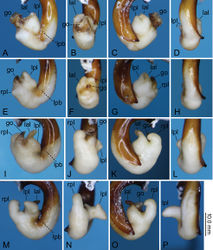Difference between revisions of "Pterostichus namahage"
m (Imported from Deutsche Entomologische Zeitschrift) |
m (1 revision imported) |
(No difference)
| |
Latest revision as of 15:06, 17 August 2023
| Notice: | This page is derived from the original publication listed below, whose author(s) should always be credited. Further contributors may edit and improve the content of this page and, consequently, need to be credited as well (see page history). Any assessment of factual correctness requires a careful review of the original article as well as of subsequent contributions.
If you are uncertain whether your planned contribution is correct or not, we suggest that you use the associated discussion page instead of editing the page directly. This page should be cited as follows (rationale):
Citation formats to copy and paste
BibTeX: @article{Sasakawa2023DeutscheEntomologischeZeitschrift70, RIS/ Endnote: TY - JOUR Wikipedia/ Citizendium: <ref name="Sasakawa2023Deutsche Entomologische Zeitschrift70">{{Citation See also the citation download page at the journal. |
Genus: Pterostichus
Name
Pterostichus namahage Sasakawa & Mitsuduka sp. nov. – Wikispecies link – ZooBank link – Pensoft Profile
Type material
Holotype, ♂, Haraikawa, Honzanmonzen, Funagawaminato, Oga-shi, Akita Prefecture, Japan (MGRS: 54SUK92241 16384; 39.89067718°N, 139.73961047°E), 28. v–30. vi. 2022, subterranean baited trap, Y. Mitsuduka leg., in the collection of NSMT (Fig. 2A).
Description
Body length (mm). ♂ (n = 1), BLm 13.15, BLl 12.32, BLc 11.96.
Head. Mandibular surface with several short wrinkles at middle. Anterior–posterior length of tempora slightly longer than anterior–posterior length of eye. Surface of clypeus smooth. Antennal segment 2 with two setae. Mentum tooth shallowly bifid; width between paired apices three times anterior–posterior length between level of mentum apices to level of innermost part of median notch.
Pronotum. Lateral margin arcuate on apical 4/5, only slightly sinuate on basal 1/5. Anterior margin emarginated, with contour arched more strongly than curvature of apical 4/5 of lateral margin. Posterior margin slightly emarginated at median area and slightly arcuate at lateral areas, with curvatures of both the same as curvature of basal 1/5 of lateral margin. Hind angles slightly acute. Median line absent near anterior margin and in front of transverse grooved area between laterobasal impressions. Transverse grooved area between laterobasal impressions concave to same degree as laterobasal impressions. Surface including laterobasal impressions smooth.
Elytra. Scutellar-stria not connected to stria 1. One setigerous puncture in front of level of posterior end of scutellum. Posterior setigerous punctures on interval 3 slightly in front of posterior 1/4.
Abdominal ventral sides. Sternum 7 of male moderately concave, with degree of concavity greater than that of convexity of median area of sterna; shape of concave area transverse ellipse; posterior margin of ellipse corresponding to posterior margin of sternum; anterior–posterior length of concave area slightly longer than 1/2 anterior–posterior length of sternum 7; transverse, major axis of ellipse about 1.4 times that of longitudinal minor axis; area corresponding to minor axis of ellipse posterior to major axis slightly raised.
Male genitalia. Endophallus with gonopore directed basal-ventrally; left pigmented band weakly sclerotised; distinct right preapical lobe absent, but corresponding area slightly swollen; left preapical lobe with basal part protruding left-laterally; left apical lobe short, not bent, bifurcated (Fig. 4A–D). Relative sizes of lobes: right apex of bifurcated left apical lobe apex ≈ basal protrusion of left preapical lobe >> left apex of bifurcated left apical lobe apex. Right paramere short, straight, with apex rounded (Fig. 6A).
Female. Unknown.
Etymology
The specific name is a noun in apposition and derives from Namahage, which is a famous folk event held on the Oga Peninsula, where the type specimen was collected.
Original Description
- Sasakawa, K; Mitsuduka, Y; 2023: A morphology-based revision and phylogenetic analysis of the Pterostichus macrogenys species group (Coleoptera, Carabidae) and implications for differentiation of the species group Deutsche Entomologische Zeitschrift, 70(2): 291-310. doi
Images
|


